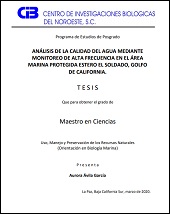| dc.contributor.advisor | Arreola Lizárraga, Jose Alfredo | |
| dc.contributor.author | Ávila García, Aurora | |
| dc.date.issued | 2020-03 | |
| dc.identifier | https://cibnor.repositorioinstitucional.mx/jspui/handle/1001/1893 | |
| dc.identifier.uri | http://dspace.cibnor.mx:8080/handle/123456789/3036 | |
| dc.description.abstract | "El monitoreo continuo de alta frecuencia de las características del agua de lagunas costeras mediante sensores in situ proporciona información más precisa de su variabilidad. El objetivo de este estudio fue conocer el comportamiento de la calidad de agua mediante monitoreo de características físico-químicas con registros cada 30 minutos durante un ciclo anual en el Área Natural Protegida estero El Soldado, Golfo de California. Se obtuvieron registros de, temperatura, oxígeno disuelto salinidad y pH del agua con una sonda multiparamétrica marca HYDROLAB modelo DATASONDE 5X, la cual fue programada para registrar cada 30 minutos desde las 9:00 horas del 07 de junio del 2016 hasta las 23:30 horas del 30 de junio del 2017. Los datos se organizaron en una hoja de cálculo Microsoft® Office Excel y se elaboraron gráficas de línea para mostrar el comportamiento anual de temperatura, oxígeno disuelto salinidad y pH. Los registros de pH y porcentaje de saturación de oxígeno disuelto se utilizaron para estimar la variabilidad anual del estado trófico mediante el Índice Simple de Estado Trófico. Adicionalmente, se seleccionaron dos eventos de lluvias, uno en 2016 asociado al huracán Newton y otro en 2017 asociado a la tormenta tropical Lidia para conocer su efecto en el comportamiento de salinidad del agua. Información de viento y precipitación se registró cada 10 minutos con una estación meteorológica marca Davis modelo Vantage Vue 62050M ubicada adyacente al estero. Los datos de precipitación, viento y salinidad se procesaron con el software MATLAB y se elaboraron gráficos para mostrar y comparar el comportamiento de estas variables durante los eventos meteorológicos. Los resultados mostraron que la temperatura del agua durante junio, julio, agosto, septiembre y parte de octubre fluctuó entre 30 y 34 °C; en seis semanas, desde mediados de octubre y hasta finales de noviembre ocurre un marcado descenso desde 30 hasta 20 °C; el periodo de diciembre, enero y febrero es el periodo más frío del año con temperatura de 15-20 °C; durante marzo, abril y mayo los valores fluctúan entre 20 y 28 °C. Concentraciones de oxígeno disuelto < 4 mg L-1 se observaron como eventos puntuales durante julio, agosto y septiembre, y eventos de hipoxia (< 3 mg L-1) ocurrieron uno en julio y otro en agosto por periodos menores a tres horas..." | es |
| dc.format | pdf | es |
| dc.language.iso | spa | es |
| dc.publisher | Centro de Investigaciones Biológicas del Noroeste, S.C. | es |
| dc.rights | Acceso abierto | es |
| dc.subject | Laguna costera, calidad del agua, estado trófico, monitoreo de alta frecuencia | es |
| dc.subject | coastal lagoon, water quality, trophic state, high-frequency monitoring | es |
| dc.subject.classification | PROCESOS LITORALES O SUBLITORALES | es |
| dc.title | ANÁLISIS DE LA CALIDAD DEL AGUA MEDIANTE MONITOREO DE ALTA FRECUENCIA EN EL ÁREA MARINA PROTEGIDA ESTERO EL SOLDADO, GOLFO DE CALIFORNIA. | es |
| dc.type | masterThesis | es |
| dc.dirtesis.grado | Maestría en Ciencias en el Uso, Manejo y Preservación de los Recursos Naturales | es |
| dc.dirtesis.disciplina | Biología Marina | es |
| dc.dirtesis.universidad | Centro de Investigaciones Biológicas del Noroeste, S.C. | es |
| dc.dirtesis.facultad | Posgrado en Recursos Naturales | es |
| dc.description.abstracten | "Continuous high-frequency monitoring of estuarine water quality by on-site sensors provides a more accurate information on the variability of their physical-chemical characteristics. The objective of this study was to know the behavior of water quality by monitoring physical-chemical characteristics with records every 30 minutes during an annual cycle in the estuary El Soldado Natural Protected Area, Gulf of California. Records of temperature, salinity, dissolved oxygen and pH of the water were obtained with a HYDROLAB model DATASONDE 5X multiparameter probe, which was programmed to record every 30 minutes from 9:00 a.m. on June 7, 2016 until 11:30 p.m. hours of June 30, 2017. The data was organized in a Microsoft® Office Excel spreadsheet and line graphs were prepared to show the annual behavior of temperature, salinity, dissolved oxygen and pH. The pH and percentage saturation of dissolved oxygen records were used to estimate the annual variability of the trophic state using the Simple Index of Trophic Status (SITS). Additionally, two rain events were selected, one in 2016 associated with Hurricane Newton and another in 2017 associated with Tropical Storm Lidia to know its effect on water salinity behavior. Wind and precipitation information was recorded every 10 minutes with a Davis Vantage Vue 62050M weather station located adjacent to the estuary. Precipitation, wind and salinity data were processed with MATLAB software and graphs were developed to show and compare the behavior of these variables during weather events. The results showed that the water temperature during June, July, August, September and part of October fluctuated between 30 and 34 °C; in six weeks, from mid-October until the end of November a marked decrease from 30 to 20 °C occurs; the period of December, January and February is the coldest period of the year with a temperature of 15-20 ° C; during March, April and May the values fluctuate between 20 and 28 °C. Dissolved oxygen concentrations <4 mg L-1 were observed as specific events during July, August and September, and hypoxia events (<3 mg L-1) occurred one in July and one in August for periods of less than three hours. In the estuary there is an increase in concentrations of dissolved oxygen in the water and greater daytime variability with values between 5 and 10 mg L-1 during December, January, February and March..." | es |

